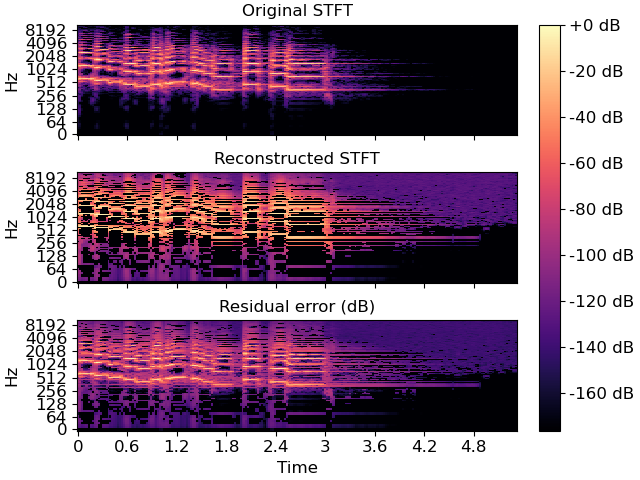Caution
You're reading the documentation for a development version. For the latest released version, please have a look at 0.11.0.
librosa.feature.inverse.mel_to_stft
- librosa.feature.inverse.mel_to_stft(M, *, sr=22050, n_fft=2048, power=2.0, **kwargs)[source]
Approximate STFT magnitude from a Mel power spectrogram.
- Parameters:
- Mnp.ndarray [shape=(…, n_mels, n), non-negative]
The spectrogram as produced by feature.melspectrogram
- srnumber > 0 [scalar]
sampling rate of the underlying signal
- n_fftint > 0 [scalar]
number of FFT components in the resulting STFT
- powerfloat > 0 [scalar]
Exponent for the magnitude melspectrogram
- **kwargsadditional keyword arguments for Mel filter bank parameters
- fminfloat >= 0 [scalar]
lowest frequency (in Hz)
- fmaxfloat >= 0 [scalar]
highest frequency (in Hz). If None, use
fmax = sr / 2.0- htkbool [scalar]
use HTK formula instead of Slaney
- norm{None, ‘slaney’, or number} [scalar]
If ‘slaney’, divide the triangular mel weights by the width of the mel band (area normalization). If numeric, use
librosa.util.normalizeto normalize each filter by to unit l_p norm. Seelibrosa.util.normalizefor a full description of supported norm values (including +-np.inf). Otherwise, leave all the triangles aiming for a peak value of 1.0- dtypenp.dtype
The data type of the output basis. By default, uses 32-bit (single-precision) floating point.
- Returns:
- Snp.ndarray [shape=(…, n_fft, t), non-negative]
An approximate linear magnitude spectrogram
Examples
>>> y, sr = librosa.load(librosa.ex('trumpet')) >>> S = librosa.util.abs2(librosa.stft(y)) >>> mel_spec = librosa.feature.melspectrogram(S=S, sr=sr) >>> S_inv = librosa.feature.inverse.mel_to_stft(mel_spec, sr=sr)
Compare the results visually
>>> import matplotlib.pyplot as plt >>> fig, ax = plt.subplots(nrows=3, sharex=True, sharey=True) >>> img = librosa.display.specshow(librosa.amplitude_to_db(S, ref=np.max, top_db=None), ... y_axis='log', x_axis='time', ax=ax[0]) >>> ax[0].set(title='Original STFT') >>> ax[0].label_outer() >>> librosa.display.specshow(librosa.amplitude_to_db(S_inv, ref=np.max, top_db=None), ... y_axis='log', x_axis='time', ax=ax[1]) >>> ax[1].set(title='Reconstructed STFT') >>> ax[1].label_outer() >>> librosa.display.specshow(librosa.amplitude_to_db(np.abs(S_inv - S), ... ref=S.max(), top_db=None), ... vmax=0, y_axis='log', x_axis='time', cmap='magma', ax=ax[2]) >>> ax[2].set(title='Residual error (dB)') >>> fig.colorbar(img, ax=ax, format="%+2.f dB")
